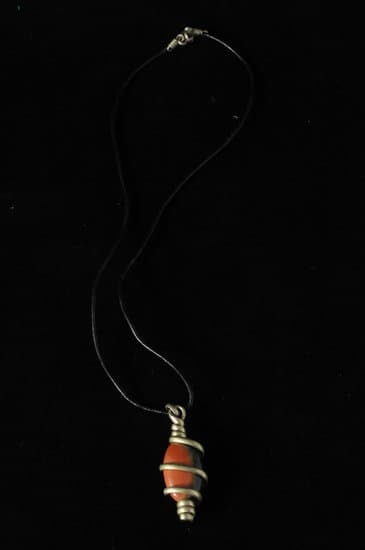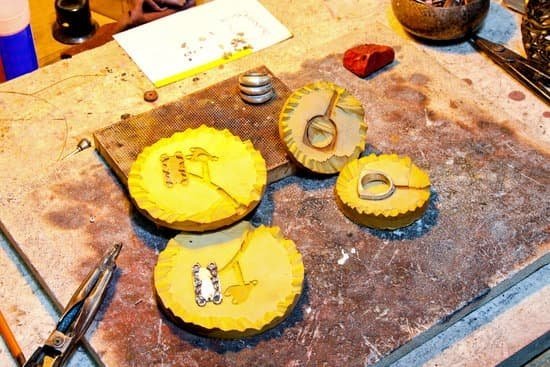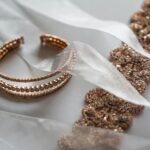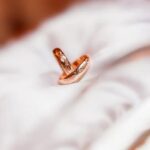Interested in finding out whether that beautiful vintage ring or necklace you scored at the thrift store is adorned with real diamonds? Look no further. In this article, we will guide you through the process of identifying if your thrifted jewelry really contains diamonds.
In recent years, thrifting has become more popular than ever, as people seek unique and affordable fashion choices. The appeal of thrifted jewelry lies in its ability to offer one-of-a-kind pieces that cannot be found anywhere else. Not only does thrifting allow individuals to express their personal style, but it also provides an opportunity to stumble upon valuable treasures at a fraction of their original price.
However, when it comes to jewelry, particularly diamonds, determining authenticity can be a daunting task for many. That’s why we’re here to help.
Before delving into the specifics of identifying diamond jewelry, it is crucial to understand the basics of diamonds themselves. Diamonds are graded using the 4 Cs: Cut, Color, Clarity, and Carat weight. Each of these factors plays a significant role in determining a diamond’s value and overall appearance. Throughout this article, we will explore each factor in detail and explain how they can help you spot real diamonds amongst imitations.
So join us on this journey as we unveil the secrets of identifying genuine diamonds in thrifted jewelry. Whether you’re an avid thrifter or just beginning your treasure-hunting adventures, this comprehensive guide will equip you with the knowledge needed to make informed decisions and find those hidden diamond treasures.
The Basics of Diamonds
Diamonds are one of the most coveted gemstones in the world, known for their brilliance and timeless beauty. To determine the value and quality of a diamond, jewelers use a grading system based on four criteria, commonly referred to as the 4 Cs: Cut, Color, Clarity, and Carat weight. Understanding these factors is essential when assessing thrifted jewelry for potential diamonds.
Firstly, the cut of a diamond refers to how well it has been shaped and faceted. The cut affects how light interacts with the diamond, ultimately determining its sparkle and brilliance. A well-cut diamond reflects light internally and externally, creating a dazzling appearance. When examining thrifted jewelry, look for diamonds with precise proportions and symmetrical facets for optimal performance.
Next, color plays a significant role in a diamond’s value. The Gemological Institute of America (GIA) grades diamonds on a scale from D (colorless) to Z (light yellow or brown). While colorless diamonds are generally more valuable, some people prefer diamonds with subtle hints of color for their unique character. When evaluating thrifted jewelry for potential diamonds, look for stones that appear colorless or have minimal visible hues.
Clarity refers to the presence of internal flaws or external blemishes in a diamond. GIA grades clarity on a scale from Flawless (no inclusions or blemishes visible under 10x magnification) to Included (inclusions that are easily visible). In thrifted jewelry, examine the diamonds carefully under magnification for any imperfections that may affect their appearance and value.
Lastly, carat weight is an important consideration when assessing the size of a diamond. One carat is equivalent to 200 milligrams or 0.007 ounces. Higher carat weights usually indicate larger stones and can significantly impact the price of the diamond. In thrifted jewelry, consider both individual stone sizes as well as total carat weight to determine the value of potential diamonds.
By understanding the basics of the 4 Cs, individuals searching for diamonds in thrifted jewelry can make more informed decisions. Remember that professional assistance from a certified gemologist may be necessary for an accurate assessment. With the right knowledge and tools, one can uncover incredible treasures while thrifting.
Recognizing Authenticity
When it comes to thrifted jewelry, determining whether or not a piece is genuine can be a challenge. However, there are several expert tips and tricks that can help you identify real diamonds amidst imitations. By paying attention to key features and conducting simple tests, you can increase your chances of recognizing authenticity.
One method to determine whether a diamond is real or fake is the breath test. This involves breathing onto the diamond as if you were fogging up a window. Real diamonds disperse heat quickly and won’t retain any fog or condensation, while fake diamonds may take longer to clear up.
Another test that can be done is the fog test. Simply place the diamond in front of your mouth and exhale onto it, just like you would for the breath test. If the diamond fogs up and takes a few seconds to clear, it may be a fake. Real diamonds have high thermal conductivity, so they should not retain any fog at all.
Additionally, conducting the scratch test can provide further insight into a diamond’s authenticity. Diamonds are one of the hardest substances on Earth so they should not scratch easily when scraped against certain materials such as glass or metal. Be cautious when using this test as scratching genuine diamonds may decrease their value.
To assist you in your quest for authentic thrifted jewelry, there are essential tools that can come in handy – diamond testers and loupes. Diamond testers are electronic devices that determine whether or not a gemstone is a real diamond based on its thermal conductivity. Loupes, on the other hand, are small magnifying glasses used by gemologists and jewelers to closely inspect diamonds for clarity characteristics and inclusions.
By utilizing these expert tips and tools, you can enhance your ability to recognize authenticity when searching for diamonds in thrifted jewelry. Remember though, while these methods can be useful indicators, it is always recommended to consult a certified gemologist or expert for a more accurate assessment. Their expertise can help you avoid costly mistakes and ensure you are getting the most out of your thrifted treasures.
Assessing Diamond Quality
When it comes to assessing the quality of diamonds in thrifted jewelry, understanding the 4 Cs is crucial. The 4 Cs – Cut, Color, Clarity, and Carat weight – play a significant role in determining a diamond’s value and appearance. By examining these factors closely, you can make an informed decision about the quality of the diamonds present.
Evaluating Cut
The cut of a diamond refers to how well it has been shaped and faceted. A well-cut diamond reflects light brilliantly and exhibits maximum sparkle. When assessing the cut of diamonds in thrifted jewelry, examine how symmetrical the facets are and whether they align properly. It’s important to note that certain antique cuts may differ from modern standards but can still be valuable if executed well for their time period.
Assessing Color
Diamond color varies on a scale from D (colorless) to Z (light yellow or brown). Generally, the less color a diamond has, the more valuable it is considered. When inspecting thrifted jewelry for diamond color, examine them under different lighting conditions. Look for stones that appear white or have minimal noticeable tint under both natural light and artificial lighting sources.
Determining Clarity
Diamond clarity refers to the presence or absence of internal and external flaws or blemishes called inclusions and blemishes. These can impact a diamond’s brilliance and overall visual appeal. To assess clarity in thrifted jewelry, use a magnifying loupe to look for any visible imperfections within the stone. Keep in mind that some minor flaws may be acceptable depending on their size, position, and overall impact on beauty.
Evaluating Carat Weight
Carat weight measures how much a diamond weighs. In general, the greater the carat weight, the more valuable the diamond is considered. When trying to determine a diamond’s carat weight in thrifted jewelry, compare its size to known reference points. Use a calibrated scale if one is available, but keep in mind that assessing carat weight accurately without professional equipment can be challenging.
It’s important to approach understanding the 4 Cs with a discerning eye when evaluating thrifted jewelry for diamond quality. While keeping these factors in mind can give you valuable insights, it’s always recommended to consult a certified gemologist for a more precise assessment of your findings.
They have the expertise and tools necessary to provide accurate evaluations and ensure that you are making an informed purchase or investment decision. By considering the 4 Cs and seeking professional assistance when needed, you can confidently assess diamonds in thrifted jewelry and uncover extraordinary treasures.
Inspecting the Setting
Types of Settings
When examining thrifted jewelry for diamonds, it is important to understand the different types of settings commonly used for diamond jewelry. One popular setting is the prong or claw setting, where small metal prongs hold the diamond securely in place. Another common option is the bezel setting, which encircles the diamond with a metal rim for added protection.
Other settings include pave, channel, and tension settings, each offering unique characteristics and styles. Familiarizing yourself with these settings can help you determine if a piece of thrifted jewelry may contain genuine diamonds.
Examining Hallmarks and Metal Purity
One effective way to determine the authenticity of a diamond in thrifted jewelry is by examining any hallmarks or stamps on the jewelry itself. Look for markings such as “750” or “18K,” which indicate that the metal used is at least 75% pure gold or 18 karats.
In addition to these symbols indicating gold purity, other hallmarks or engravings may provide clues about the manufacturer or origin of the piece. Also pay attention to any discoloration or signs of wear on the metal, as this may indicate how long ago it was last polished or if any repairs have been made.
Utilizing Diamond Testers and Loupes
In addition to visual examination, utilizing tools such as diamond testers and loupes can greatly assist in identifying authentic diamonds in thrifted jewelry. Diamond testers are handheld electronic devices that measure thermal conductivity to distinguish between genuine diamonds and diamond simulant materials like cubic zirconia.
Loupes, on the other hand, are magnifying glasses used to closely inspect diamonds for imperfections such as inclusions or color discrepancies that could reveal their true quality. By incorporating these tools into your inspection process, you can gain more confidence in determining whether a piece of thrifted jewelry contains genuine diamonds.
Professional Assistance
Seeking professional assistance is highly recommended when it comes to determining the authenticity and value of thrifted jewelry. Consulting a certified gemologist can provide a more accurate assessment and ensure that you are making an informed purchase. Here are some reasons why seeking expert opinion is valuable:
- Knowledge and Expertise: Certified gemologists have undergone extensive training and education in gemology, equipping them with in-depth knowledge about diamonds and other precious gemstones. Their expertise allows them to accurately identify, evaluate, and appraise the quality of diamonds found in thrifted jewelry.
- Precise Appraisals: A professional appraisal conducted by a certified gemologist will determine both the authenticity and value of the diamond. This information is crucial for insurance purposes or if you plan to resell the jewelry in the future. An appraisal provides an unbiased evaluation based on industry standards and can help protect you from overpaying or being deceived by counterfeit stones.
- Prevention of Fraud: Unfortunately, there are dishonest individuals who may try to pass off fake or low-quality diamonds as genuine ones, especially in second-hand markets like thrift stores. Seeking professional assistance reduces the risk of falling victim to scams or purchasing misrepresented jewelry. A certified gemologist can verify the authenticity of diamonds through advanced testing methods and their trained eye.
When choosing a gemologist, look for certifications from reputable organizations such as the Gemological Institute of America (GIA) or American Gem Society (AGS). These certifications ensure that the expert has met high standards of knowledge and professionalism in the field of gemology.
Although consulting a certified gemologist may incur an additional cost, their assessment can ultimately save you money by ensuring that you are making an informed decision about your thrifted jewelry purchases. It’s worth considering their expertise to make sure you are getting what you pay for.
Remember, while it’s exciting to find potential diamonds in thrifted jewelry, seeking professional assistance is essential for accurate assessments and peace of mind. With their knowledge, experience, and tools, gemologists can provide guidance and help you uncover the true value of your thrifted treasures.
Tools of the Trade
Thrifted jewelry can be a treasure trove of hidden gems, but sometimes it can be difficult to determine whether a piece contains real diamonds or is simply an imitation. This is where the tools of the trade come in handy. Utilizing diamond testers and loupes can help you confidently identify diamonds and ensure that you are getting the real deal.
Diamond testers are electronic devices specifically designed to test the thermal conductivity of gemstones, which is a unique property of diamonds. These handheld instruments emit heat onto the surface of a stone and measure how quickly the heat dissipates. If the stone conducts heat rapidly, it is likely not a real diamond. Diamond testers are widely available and relatively easy to use, making them a popular tool for enthusiasts and professionals alike.
Loupes, on the other hand, are small magnifying devices that allow you to view jewelry up close and examine its characteristics in detail. These tools are essential for identifying microscopic imperfections in diamonds, such as inclusions or blemishes, which can affect their value. By using a loupe with high magnification power (often around 10x), you can inspect thrifted jewelry more closely and look for signs of authenticity.
| Diamond Testers | Loupes |
|---|---|
| Diamond testers measure thermal conductivity | Loupes provide high magnification power |
| Widely available and easy to use | Allows examination of microscopic imperfections |
| Helps determine if a stone is likely a diamond | Useful for looking for signs of authenticity in thrifted jewelry |
When using diamond testers or loupes, it’s important to note that they are not foolproof methods for identifying real diamonds. Some diamond alternatives, such as moissanite or cubic zirconia, can have similar thermal conductivity properties as real diamonds and may appear visually similar under magnification. However, these tools can still provide valuable information and help you make a more informed decision when purchasing thrifted jewelry.
Common Mistakes to Avoid
In order to avoid costly mistakes when trying to determine if thrifted jewelry contains diamonds, it is important to be aware of common mistakes and misconceptions. Many people fall for diamond look-alikes, which can lead to disappointment and financial loss. By being mindful of these errors, shoppers can protect themselves and make more informed decisions when purchasing thrifted jewelry.
One common mistake is assuming that all clear gemstones are diamonds. While diamonds are known for their clarity, there are other gemstones such as cubic zirconia or white sapphire that can also appear clear. These gemstones may have a similar sparkle as diamonds and can easily deceive an untrained eye. It is important to recognize that diamonds possess distinctive characteristics beyond just clarity, such as the 4 Cs mentioned earlier in this article.
Another mistake to avoid is relying solely on visual appearance when determining if a piece of jewelry contains diamonds. Although some imitations may closely resemble real diamonds at first glance, they often lack the same brilliance and fire that genuine diamonds exhibit. To accurately identify authentic diamonds, it is crucial to conduct certain tests and inspections highlighted in the previous section.
Lastly, many people mistakenly assume that price alone can determine whether a piece of thrifted jewelry contains diamonds. While it is true that genuine diamond jewelry generally carries a higher price tag than imitations or other gemstones, this is not always the case when shopping second-hand or at thrift stores. Sometimes valuable pieces of jewelry can go unnoticed or undervalued due to various factors, such as sellers not recognizing the true worth of their items or unique market conditions.
By avoiding these common mistakes and misconceptions, individuals can better navigate the realm of thrifted jewelry and improve their chances of identifying genuine diamonds. The next step in this journey involves seeking professional assistance for a more accurate assessment or utilizing tools like diamond testers and loupes for further examination.
| Mistake | Explanation |
|---|---|
| Assuming all clear gemstones are diamonds | Not all clear gemstones are diamonds; other gemstones like cubic zirconia or white sapphire can also appear clear. |
| Relying solely on visual appearance | Genuine diamonds possess characteristics beyond just clarity, such as brilliance and fire. Visual appearance alone is not enough to determine authenticity. |
| Believing price alone determines if jewelry contains diamonds | Price is not always a reliable indicator as valuable pieces of jewelry can go unnoticed or undervalued for various reasons. |
Conclusion
In conclusion, thrifting for jewelry can be a rewarding and thrilling experience. The allure of finding unique pieces at a fraction of the cost is what draws many people to scour thrift stores and vintage markets.
Through this article, we have explored the basics of diamonds, including the 4 Cs that determine their value and appearance. We have also discussed various methods to recognize authenticity, evaluate diamond quality, inspect settings, seek professional assistance, and utilize essential tools in order to identify diamonds in thrifted jewelry.
While it may seem daunting at first, with the right knowledge and guidance, anyone can uncover incredible treasures in thrifted jewelry. By understanding how cut, color, clarity, and carat weight affect a diamond’s value and using expert tips to differentiate between real diamonds and imitations, one can increase their chances of finding authentic diamonds amidst thrifty finds. Carefully examining the setting for hallmarks and metal purity is also crucial in determining authenticity.
Furthermore, seeking a professional opinion from a certified gemologist can provide an accurate assessment of thrifted jewelry’s value and authenticity. Professional appraisals not only save money but also prevent falling victim to possible scams or misinterpretations that could lead to costly mistakes. Additionally, utilizing diamond testers and loupes can give further insight into whether or not thrifted jewelry contains diamonds.
In the end, embracing the adventure and excitement of finding diamonds in thrifted jewelry is key. By fully understanding the tips and tricks outlined in this article, readers are well-equipped to embark on their own treasure hunts.
Remembering that every piece has its own story waiting to be discovered adds an extra layer of fascination to thrifting for jewelry. So go forth with confidence; there may just be a dazzling diamond waiting for you amidst the roughness of thrifted treasures.
Frequently Asked Questions
How can you tell if old diamond jewelry is real?
To determine if old diamond jewelry is real, there are several visual and physical tests you can conduct. Firstly, inspect the diamond for any visible imperfections or flaws known as inclusions, as real diamonds often have these naturally occurring characteristics. Additionally, assess the diamond’s clarity by observing its transparency and ability to reflect light.
Genuine diamonds have an exceptional brilliance and sparkle due to their high refractive index. Another indicator of authenticity is a diamond’s hardness; it should be able to scratch glass without getting scratched itself. Lastly, consider seeking professional appraisal or consulting with a certified gemologist who can use advanced testing methods like thermal conductivity or ultraviolet light to accurately authenticate the diamond.
How is diamond marked on jewelry?
Diamond markings on jewelry can vary depending on the type and quality of the piece. One common marking to look for is a stamp or engraving indicating the metal’s purity, such as “10K,” “14K,” or “18K” for gold jewelry, or “925” for sterling silver which may be used alongside diamonds. Additionally, some jewelers mark diamonds with unique serial numbers or identification codes to aid in traceability and authentication.
However, it’s important to note that not all diamond jewelry will have visible markings, especially if they are very small stones in intricate settings. In these cases, it may be necessary to consult with a professional jeweler who can use specialized tools to accurately identify and verify the presence of diamonds.
How can I tell if a diamond is real with a flashlight?
While using a flashlight alone may not provide foolproof results when determining if a diamond is real, there are certain properties you can observe under appropriate lighting conditions. First and foremost, turn off any additional lights and use natural daylight or a direct source of bright white light from your flashlight. Hold the diamond close to your eye level and look for reflections within it — genuine diamonds tend to refract light differently than imitations due to their high dispersion of light, resulting in multicolored flashes called “fire.”
Focus on the diamond’s brilliance, checking for a bright white light that reflects from different facets. It is also worth noting that a real diamond will not fog up easily when you breathe on it, as its high thermal conductivity quickly dissipates heat. However, it is crucial to keep in mind that these methods can only serve as initial indicators, and consulting with a professional gemologist or using advanced testing techniques would be necessary for an accurate and definitive evaluation of a diamond’s authenticity.

Welcome to my jewelry blog! My name is Sarah and I am the owner of this blog.
I love making jewelry and sharing my creations with others.
So whether you’re someone who loves wearing jewelry yourself or simply enjoys learning about it, be sure to check out my blog for insightful posts on everything related to this exciting topic!





